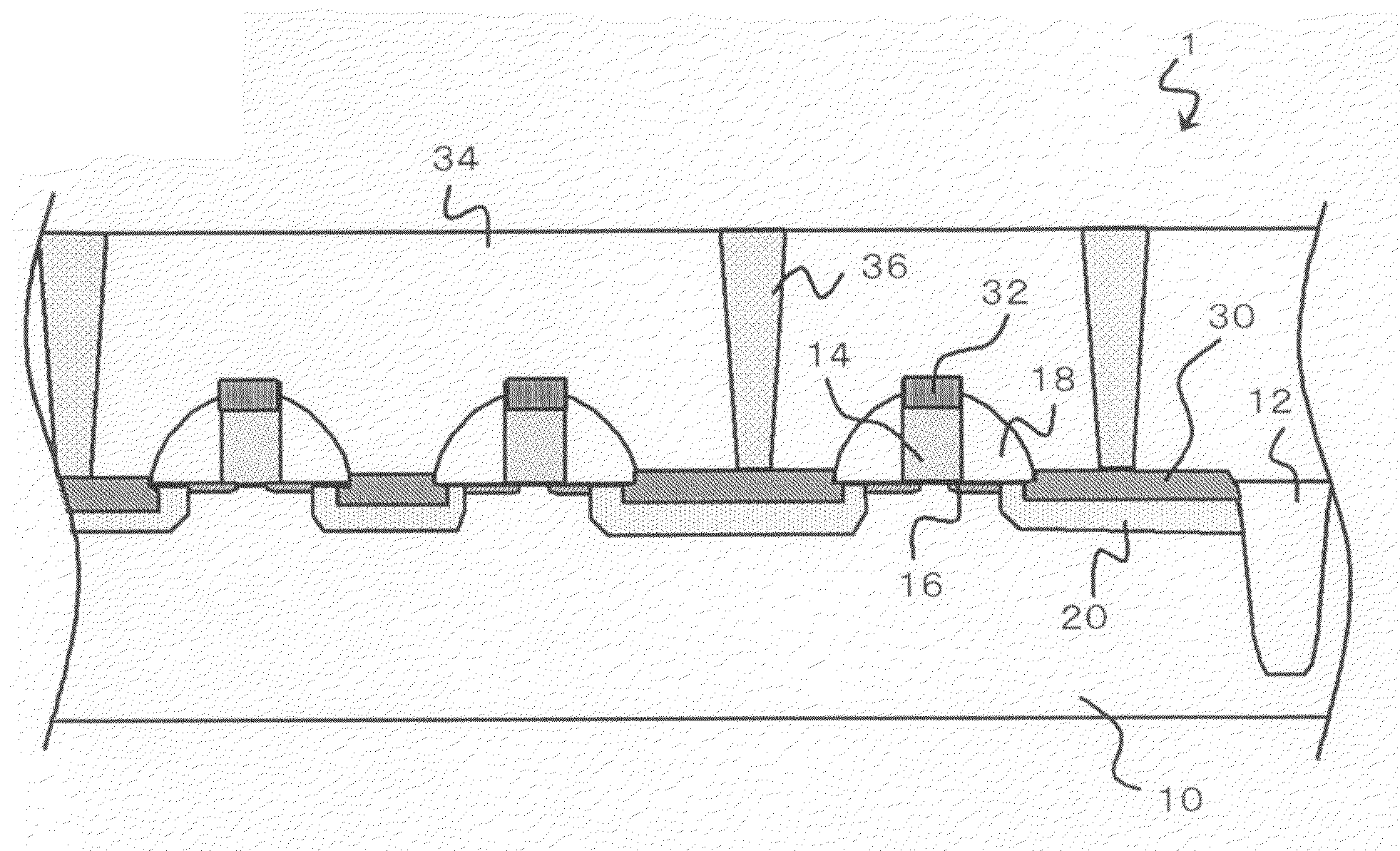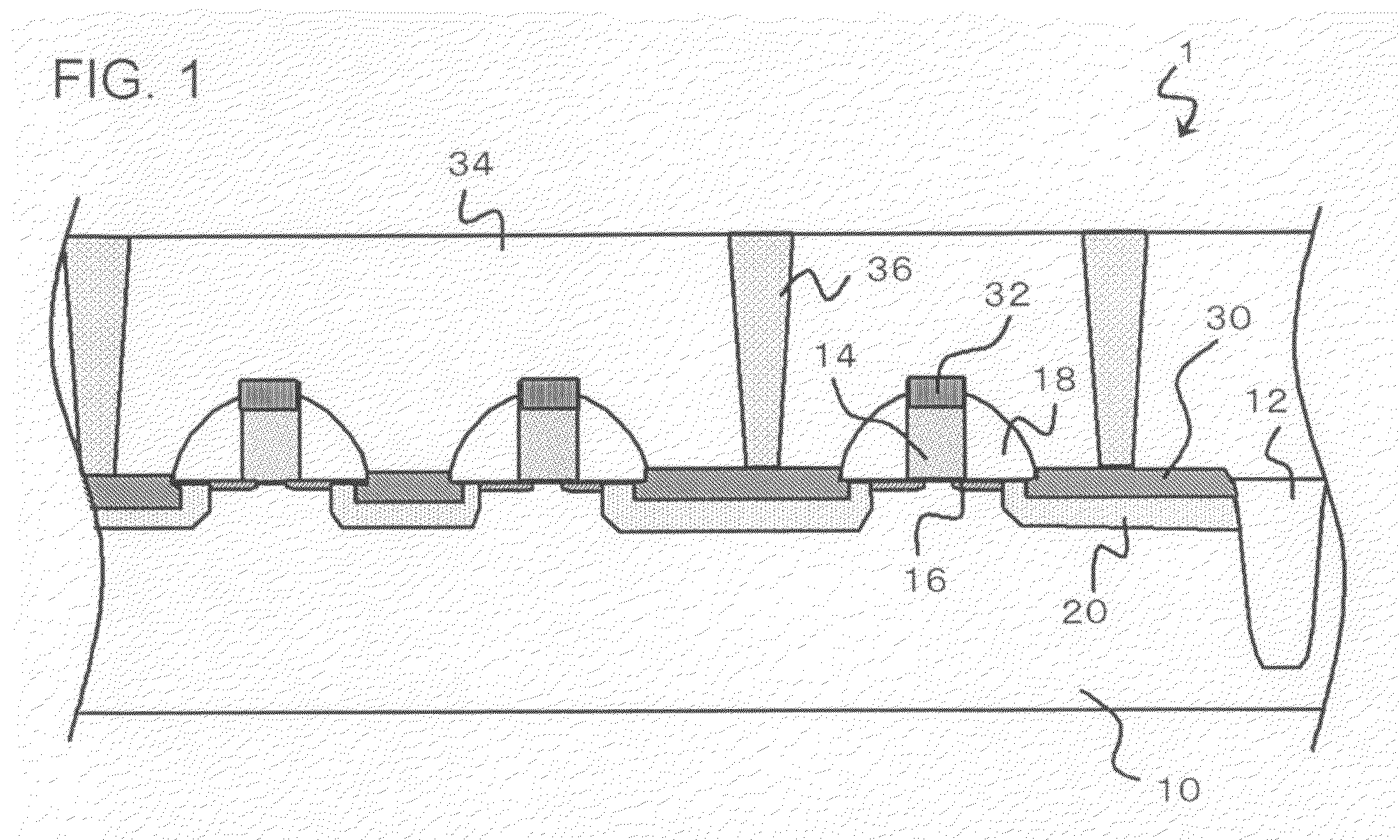Semiconductor device and method of fabricating the same
a technology of semiconductor devices and semiconductor layers, applied in the direction of semiconductor devices, electrical equipment, transistors, etc., can solve the problems of junction leakage and resistivity increase of conventional semiconductor devices, and achieve the effect of reducing the junction leakage and lowering the resistivity of the silicide layer
- Summary
- Abstract
- Description
- Claims
- Application Information
AI Technical Summary
Benefits of technology
Problems solved by technology
Method used
Image
Examples
first embodiment
[0048]FIG. 1 is a sectional view illustrating a semiconductor device 1 of the first embodiment. The semiconductor device 1 has transistors formed on a semiconductor substrate 10. The gate electrode of each transistor is composed of a polysilicon electrode 14 and a silicide layer 32 formed thereon. The semiconductor device 1 further has low-concentration doped regions 16, source / drain impurity-diffused layers 20 composed of high-concentration doped regions, and silicide layers 30 formed over the source / drain impurity-diffused layers 20. The surface of each silicide layer 30 is positioned above the surface of the semiconductor substrate 10. The silicide layers 30 contain a silicidation-suppressive metal, and have a concentration profile according to which the concentration of the silicidation-suppressive metal increases from the surface of each silicide layer 30 in the depth-wise direction of the substrate, over a region of each silicide layer 30 ranging from the surface thereof to a ...
second embodiment
[0082]A method of manufacturing a semiconductor device according to a second embodiment is same as that in the first embodiment, up to the step of forming the primary silicide layers 26, 28, and the step of removing the unreacted portions of Ni and Pt (FIG. 2A).
[0083]This embodiment differs from the first embodiment, only in that, after the unreacted portions of Ni and Pt are removed, a secondary silicide layer is formed by sputtering as illustrated in FIG. 4A.
[0084]More specifically, the unreacted portions of Ni and Pt are removed, and a silicon film 40 is formed over the entire surface by sputtering at room temperature (FIG. 4A). In this process, the silicon film 40 is formed also over the sidewalls 18 and STI 12.
[0085]Next, the product is annealed at 500° C. for 30 seconds, so as to allow Ni and Pt to diffuse from the primary silicide layers 26, 28 to the silicon film 40, to thereby form the secondary silicide layers. The unreacted portions of the silicon film are then removed by...
third embodiment
[0093]A semiconductor device of a third embodiment is same as that in the second embodiment, in that the secondary silicide layer is formed by sputtering.
[0094]The third embodiment is, however, different from the second embodiment, in that the sidewalls are made to have nearly vertical shape as illustrated in FIGS. 5A to 5C, so as to avoid deposition of the silicon film over the surface of the sidewalls.
[0095]A method of manufacturing according to this embodiment will be explained referring to FIGS. 5A to 5C.
[0096]The source / drain impurity-diffused layers 20 are formed as the high-concentration doped regions, similarly to as described in the first embodiment. Note that the sidewalls 42 are formed to a nearly vertical shape. According to the recent tendency towards further dimensional shrinkage of semiconductor devices, the width d of the sidewalls 42 (see FIG. 5A) is 25 to 30 nm in the 45-nm generation, and 20 nm or narrower in the 32-nm generation.
[0097]More specifically, the sidew...
PUM
 Login to View More
Login to View More Abstract
Description
Claims
Application Information
 Login to View More
Login to View More - R&D
- Intellectual Property
- Life Sciences
- Materials
- Tech Scout
- Unparalleled Data Quality
- Higher Quality Content
- 60% Fewer Hallucinations
Browse by: Latest US Patents, China's latest patents, Technical Efficacy Thesaurus, Application Domain, Technology Topic, Popular Technical Reports.
© 2025 PatSnap. All rights reserved.Legal|Privacy policy|Modern Slavery Act Transparency Statement|Sitemap|About US| Contact US: help@patsnap.com



